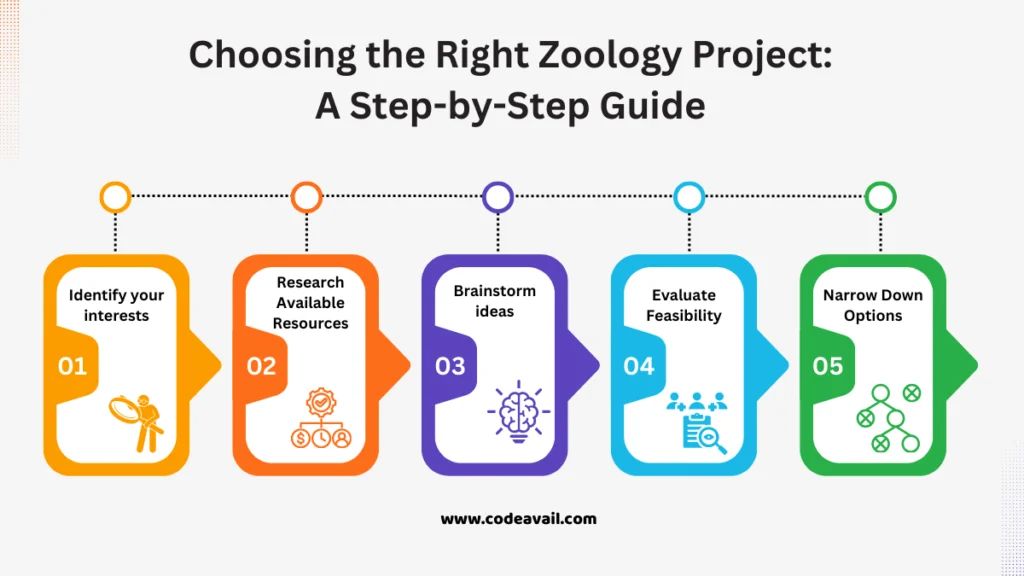Zoology is all about studying animals. It covers many areas, like how animals look inside and out, act, and live together.
It’s a big part of biology and helps us understand the different kinds of animals and how they interact with each other and their environments.
Zoology projects are super important for students. They let students get their hands dirty and learn by doing things themselves. Projects help students think hard about their learning and make remembering easier.
In addition, they show students how cool animals are and can inspire them to become scientists or help protect animals in the future. Doing projects in Zoology helps students learn better.
In this blog, we want to help students find fun and interesting ideas for their Zoology project topics. We’ll give tips, share cool topics, and make learning about animals easy and enjoyable.
Our goal is to get students excited about animals and inspire them to learn more about the awesome world of Zoology!
Zoology Project: What Is It?
Table of Contents
A Zoology project is a hands-on investigation or study focused on animals and their various aspects, such as behavior, anatomy, ecology, or evolution.
These projects allow students to explore specific topics within Zoology, conduct experiments, gather data, and draw conclusions. They often involve research, observation, and experimentation to deepen understanding of animal life and its complexities.
Zoology projects can range from simple observations and data collection to more complex experiments and analyses, offering students opportunities to develop critical thinking, research, and communication skills while gaining a deeper appreciation for the natural world.
| Also Read: Phenomenological Research Topics |
171+ Zoology Project Topics: Category-Wise
Here’s a list of Zoology project topics categorized for your convenience:
Animal Behavior
- Social hierarchy in primate groups
- Feeding behavior of nocturnal animals
- Courtship rituals in marine species
- Communication methods in insects
- Territorial behavior of mammals
- Parental care in amphibians
- Aggression among carnivorous species
- Play behavior in young mammals
- Nest-building behavior in birds
- Hunting strategies of predators
- Defensive behavior in prey species
- Sleep patterns across different animal groups
- Mate selection in reptiles
- Foraging behavior in herbivores
Anatomy and Physiology
- Comparative anatomy of vertebrates
- Digestive system adaptations in herbivores
- Respiratory system efficiency in aquatic animals
- Muscle structure and function in flighted birds
- Skeletal adaptations of desert-dwelling animals
- Reproductive anatomy in marsupials
- Nervous system development in young mammals
- Endocrine system regulation in amphibians
- Circulatory system adaptations in high-altitude species
- Sensory organ specialization in nocturnal animals
- Thermoregulation in cold-blooded animals
- Immune system response in invertebrates
- Renal system adaptations in marine mammals
- Structural adaptations for camouflage
- Hormonal regulation of behavior in primates
Ecology and Conservation
- Habitat preference of endangered species
- Impact of climate change on wildlife populations
- Biodiversity hotspots and their importance
- Human-wildlife conflict mitigation strategies
- Ecosystem services provided by insects
- Invasive species management techniques
- Effects of pollution on aquatic ecosystems
- Succession in ecological communities
- Keystone species and their role in ecosystems
- Restoration of degraded habitats
- Population dynamics of apex predators
- Conservation genetics of rare species
- Urban ecology and wildlife adaptation
- Coral reef conservation efforts
- Sustainable fisheries management practices
Evolutionary Biology
- Speciation mechanisms in island populations
- Evolutionary trends in vertebrate limb morphology
- Adaptive radiation in birds
- Coevolution of plants and pollinators
- Molecular evolution of immune system genes
- Fossil record evidence for evolutionary transitions
- Convergent evolution in unrelated species
- Evolutionary consequences of sexual selection
- Evolutionary arms race between predators and prey
- Evolution of coloration patterns in butterflies
- Evolutionary origins of parental care behaviors
- Evolutionary constraints on body size
- Evolutionary adaptations to extreme environments
- Evolution of flight in insects and birds
- Evolutionary trade-offs in life history strategies
Marine Biology
- Coral bleaching and its effects on reef ecosystems
- Deep-sea hydrothermal vent communities
- Migration patterns of marine mammals
- Marine pollution and its impact on marine life
- Adaptations of deep-sea creatures to high-pressure
- Ocean acidification and its effects on marine organisms
- Bioluminescence in deep-sea organisms
- Mangrove ecosystems and their importance
- Marine protected areas and their effectiveness
- Trophic interactions in marine food webs
- Plankton diversity and its role in marine ecosystems
- Coral reef resilience and recovery mechanisms
- Fisheries management and sustainable harvesting practices
- Estuarine ecology and habitat utilization
- Marine mammal communication and social behavior
Entomology
- Insect biodiversity in urban environments
- Pollinator decline and its consequences
- Chemical ecology of insect pheromones
- Invasive insect species and their impacts
- Biological control of agricultural pests
- Ant colony behavior and communication
- Mimicry in insects and its evolutionary significance
- Insect navigation and orientation mechanisms
- Social organization in honeybee colonies
- Insect pollination networks in ecosystems
- Insect-plant interactions and coevolution
- Seasonal variation in insect populations
- Insect morphology and functional adaptations
- Insect resistance to pesticides
- Evolutionary history of insect species
Ornithology
- Bird migration routes and stopover sites
- Avian vocalizations and communication
- Bird nesting strategies and habitat selection
- Avian reproductive biology and mating systems
- Raptor migration patterns and conservation
- Birdsong learning and cultural transmission
- Feeding ecology of birds of prey
- Bird banding and population monitoring
- Avian cognition and problem-solving abilities
- Bird diversity in urban environments
- Seabird foraging behavior and food webs
- Bird-flight biomechanics and aerodynamics
- Avian influenza and disease transmission
- Bird conservation genetics and population management
- Bird-window collision prevention strategies
Herpetology
- Amphibian decline and conservation efforts
- Reptile thermoregulation and behavior
- Snake venom evolution and toxicity
- Amphibian skin microbiome and disease resistance
- Crocodilian nesting behavior and parental care
- Reptile camouflage mechanisms and adaptations
- Amphibian metamorphosis and hormone regulation
- Reptile cognition and learning abilities
- Salamander diversity and ecological roles
- Reptile social behavior and communication
- Amphibian breeding site selection and ecology
- Turtle migration patterns and conservation challenges
- Frogs call diversity and mate attraction
- Lizard feeding ecology and dietary preferences
- Reptile habitat fragmentation and population genetics
Mammalogy
- Carnivore hunting strategies and prey selection
- Primate social structure and hierarchy
- Rodent population dynamics and disease transmission
- Cetacean communication and social behavior
- Bat echolocation and foraging ecology
- Ungulate migration patterns and seasonal movements
- Marsupial reproductive strategies and development
- Carnivore conservation genetics and population management
- Primate tool use and cultural behaviors
- Rodent impact on ecosystem dynamics
- Cetacean navigation and long-distance travel
- Bat roosting preferences and habitat selection
- Ungulate antler development and mating displays
- Marsupial pouch adaptations and function
Invertebrate Zoology
- Insect social insects and their roles in ecosystems
- Crustacean molting patterns and growth rates
- Mollusk shell morphology and diversity
- Arachnid silk production and properties
- Jellyfish locomotion and swimming mechanics
- Worm regenerative capabilities and tissue repair
- Echinoderm regeneration and tissue regeneration
- Insect metamorphosis and developmental stages
- Crustacean reproductive strategies and mating behaviors
- Mollusk feeding ecology and digestive systems
- Arachnid venom composition and effects
- Jellyfish bioluminescence and its functions
- Worm ecological roles in soil ecosystems
- Echinoderm larval development and dispersal
- Insect flight biomechanics and aerodynamics
Comparative Zoology
- Comparative anatomy of vertebrate limbs
- Reproductive strategies across animal taxa
- Neurobiology of learning and memory in different species
- Digestive system adaptations in herbivores and carnivores
- Sensory adaptations in nocturnal versus diurnal animals
- Respiratory system variations among aquatic and terrestrial species
- Social organization and communication in primates and birds
- Feeding strategies in filter-feeding versus predatory species
- Skeletal adaptations for flight in birds and bats
- Hormonal regulation of behavior in mammals and reptiles
- Thermoregulation in cold-blooded versus warm-blooded animals
- Genetic diversity and speciation in different animal groups
- Life history strategies in R-selected versus K-selected species
- Immune system responses to pathogens in different taxa
- Developmental biology and embryonic development across species
Etiology
- Animal cognition and problem-solving abilities
- Play behavior in mammalian species
- Agonistic behavior and dominance hierarchies
- Cultural transmission of behaviors in social animals
- Cooperative hunting strategies in carnivores
- Tool use and innovation in primates and birds
- Vocal communication and language development in mammals
- Ritualized displays and courtship behaviors
- Parental care and offspring development
- Altruistic behaviors and kin selection
- Territoriality and scent-marking behaviors
- Mating systems and reproductive strategies
- Social learning and observational learning in animals
- Problem-solving abilities in marine mammals
- Aggressive behaviors and conflict resolution in social groups
These project topics cover a broad range of interests within the field of Zoology, providing ample opportunities for exploration and research.
| Also Read: Neural Network Project Ideas |
Choosing the Right Zoology Project: A Step-by-Step Guide
Choosing the right Zoology project can be an exciting yet difficult task. Follow these steps to ensure you pick a project that aligns with your interests and goals:

1. Identify your interests
Consider what aspects of Zoology intrigue you the most, whether it’s animal behavior, anatomy, ecology, or conservation.
2. Research available resources
Look for relevant books, articles, and online databases to gather information on potential project topics.
3. Brainstorm ideas
Generate a list of project ideas based on your interests and the resources you’ve found.
4. Evaluate feasibility
Assess the feasibility of each idea considering factors such as time, resources, and accessibility to study subjects.
5. Narrow down options
Choose a project topic that is both feasible and aligns closely with your interests and goals.
By following these steps, you’ll be well-equipped to select a rewarding Zoology project that inspires and engages you.
Tips and Techniques for Success In Zoology Project Topics
Here are some tips and techniques to help you succeed in your Zoology project topics:
- Plan ahead: Start your project early to allow ample research, experimentation, and analysis time.
- Choose a specific focus: Narrow your topic to a manageable scope to ensure depth of exploration.
- Utilize diverse resources: Explore a variety of sources, such as books, scientific journals, and online databases, to gather information.
- Seek guidance: Consult your instructor or a mentor for advice and feedback throughout the project.
- Stay organized: To facilitate analysis and reporting, keep detailed notes, data, and references organized.
- Be creative: Think outside the box and consider innovative approaches to address your research questions.
- Collaborate: Consider collaborating with peers or experts in related fields to enhance your project’s quality and breadth.
By incorporating these tips and techniques, you’ll be well-equipped to excel in your Zoology project topics.
Summarize
Zoology project topics offer students a fascinating journey into the diverse and intricate world of animal life.
Through exploration and research, students gain valuable insights into various aspects of animal biology, behavior, ecology, and conservation.
Engaging in Zoology projects not only deepens understanding but also cultivates essential skills such as critical thinking, problem-solving, and scientific inquiry.
By studying animals and their environments, students develop a profound appreciation for the complexity and beauty of the natural world.
These projects not only contribute to academic growth but also inspire curiosity, creativity, and a sense of stewardship towards our planet’s biodiversity.
With Zoology project topics, students embark on a rewarding endeavor that empowers them to make meaningful contributions to science and conservation.
FAQs (Frequently Asked Questions)
1. What are some examples of Zoology project topics suitable for high school students?
Some examples of Zoology project topics suitable for high school students include studying animal behavior, investigating local biodiversity, exploring adaptations of specific animal species, and and examining environmental factors’ impact on wildlife populations.
2. Are there any resources or databases specifically dedicated to finding Zoology project ideas?
Yes, there are several resources and databases dedicated to finding Zoology project ideas, including scientific journals, online databases like PubMed and Google Scholar, educational websites, and books on Zoology topics for students.
3. How can I make my project topic unique and engaging?
To make your project topic unique and engaging, consider focusing on a lesser-known species or phenomenon, incorporating interdisciplinary approaches, using innovative research methods, and addressing real-world applications or implications within the field of Zoology.
4. What are some tips for conducting experiments or fieldwork for Zoology projects involving live animals?
Some tips for conducting experiments or fieldwork for Zoology projects involving live animals include obtaining proper permits, ensuring ethical treatment of animals, using appropriate handling techniques, maintaining detailed records, and seeking guidance from experienced professionals.


